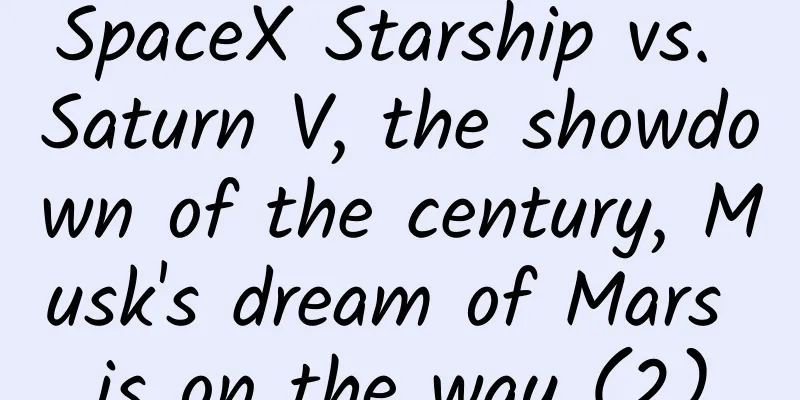SpaceX Starship vs. Saturn V, the showdown of the century, Musk's dream of Mars is on the way (2)

|
Continued from "SpaceX Starship vs. Saturn V, World Showdown, Max's Mars Dream is on the Way (1)" The ultimate goal of all Musk's investments is to allow humans to migrate to Mars On September 29, 2016 (Beijing time), Musk made a huge boast at the International Astronautical Congress (IAC) held in Adelaide, Australia: he would send 1 million people to Mars in the next few decades to 100 years. To achieve this goal, he has begun to make all-round preparations: the purpose of establishing Space X is to build the best and cheapest starship so that immigrants to Mars can afford the tickets; the Firestar ship does not rely on parachutes but on reverse thrust to land because the air on Mars is thin, which is safer and less costly. Tesla electric cars are made to solve the transportation problem on Mars, where the air is thin and there is no oxygen; SolarCity Photovoltaic Power Generation Company is made to solve the problem of using solar energy because there is no natural gas or oil on Mars; The Boring Company is made to solve the public transportation problem under Martian conditions; the Starlink project is made to solve the communication problem of Martian immigrants; and Neuralink is made to deal with the threat of artificial intelligence. Musk shocked the world with his blockbuster creation. All his plans are for the purpose of enabling humans to migrate to Mars. Why is he so keen on fighting Mars? Because he believes that humans must leave the Earth in the future. There are two main reasons: one is that the Earth will eventually become uninhabitable; the other is that when artificial intelligence develops to a high level, it may surpass humans and exclude them. To deal with the first problem, we need to implement the "Mars Colonization Plan"; to deal with the threat of artificial intelligence, we need to transform ourselves and actively integrate with machines. Neuralink is a neuroscience company co-founded by Musk and others. It is committed to injecting chips into the human brain and ultimately combining the human brain with computers, so that humans can better adapt to the new environment and new planet. To this end, he believes that humans must learn to become a multi-planet species rather than just staying on Earth and waiting to die. After 11 failures, the SN15 starship was a perfect success Many people are skeptical of Musk's "boast", and some even sneer at him completely. But some of Musk's dazzlingly fast moves make people dumbfounded, and gradually they see the facts that have to be convincing: The cars he develops are getting better and better; his research on brain-computer interface consciousness uploading has been successful on animals; and the starship he makes is already standing at the launch site in a shocking posture. It has only been five years since Musk delivered that jaw-dropping speech at the International Astronautical Congress in 2016, announcing plans to research and manufacture the SN series of starships. Success is in sight, and this success was achieved amid a series of explosions. Before December 11, 2020, Starships SN1 to SN7 were all conducting ground tests on partial components of the Starships. After watching those videos, people couldn't believe that these Starships were not as beautiful as the iron barrels made by tinsmiths in the past. Various tests caused these crappy cans to burst or deflate, not to mention how ugly they were. Could this be the starship that humans will take to Mars in the future? At that time, anyone who saw it would seem to have doubts in their hearts. But Musk and his colleagues who seemed equally crazy to outsiders were full of confidence in these shabby jars and cans, and never lost heart despite repeated failures. He even held his own children while giving instructions at the construction site, as if these jars and cans were his children too. In December 2020, Musk felt that it was time to let the children see the world, so he and his colleagues assembled the jars and cans that had passed the stage tests, and starting with SN8, conducted an overall launch experiment. In just over five months, five full-scale Starship launch tests were conducted, and the first four failed in explosions one after another. People jokingly said, "Musk's big firecracker exploded again," but on the fifth launch, SN15 returned to the ground after launch and landed steadily on the scheduled landing platform. Which country or rocket company can achieve this at such a speed? Which company, like Musk, shows the whole process of his failed experiment to the world? The fact is that some companies are very secretive about failures, even blocking the news, or finding some excuses to shirk responsibility, which is completely different from Musk's company. Under the watchful eyes of the whole world, people witnessed Musk's Starship go from a "big firecracker" to a towering structure: On December 9, 2020, SN8 went smoothly throughout the entire launch and landing process, but exploded the moment it touched the ground. Musk said it was due to the high landing speed; On February 3, 2021, SN9, like SN8, also exploded upon landing, this time due to a failure of the reentry engine; On March 4, 2021, SN10 successfully returned to the designated platform and stood firmly. Success seemed in sight, but an explosion occurred 8 minutes later. On March 30, 2021, SN11 took off amid great expectations, but unfortunately we did not see it come back this time. It was finally determined that it disintegrated in the air during its descent. In response, Musk said: It looks like there was a problem with the No. 2 engine during the ascent, so some problems occurred shortly after the landing burn began. We will know what happened when we check the recovered burning debris later. At this time, Musk made a bolder decision to abandon the already completed SN12~14 starships. Based on the many problems found in the previous test flights, he made hundreds of technical improvements and even completely changed some technical devices. In just over a month, he produced the brand new SN15, which was successfully tested on May 6, 2021. This was a perfect test flight. After the starship reached the predetermined altitude of 12 kilometers, it began to return. After completing a set of complex standard movements, it let itself fall horizontally. When it approached the ground, it adjusted the angle to land vertically with the bottom facing down. It landed steadily on the predetermined landing platform without exploding! Amid cheers, the test flight came to an end. The next step is orbital test flight, including super-heavy low-altitude, high-altitude, and suborbital test flights, until the orbital-stage fully assembled launch. From this, Musk's road to landing on Mars seems to be getting closer and closer. The difference between SN Starship and Saturn V The starship that will be tested again will be SN20. Musk did what he said and assembled SN20 in just 5 days. This giant spaceship, about the height of a 40-story building, stands tall at the SpaceX launch site, like a giant, looking down on everything around it. Raptor Engine According to the SpaceX website, the overall height of the Starship is about 120 meters, and the diameter of the launch pad is 9 meters, and it is divided into two stages. The first stage is the super heavy booster, which is 70 meters high and equipped with 29 Raptor engines, each with a thrust of 225 tons, so the takeoff mass can reach 6,525 tons; the second stage is the Starship body, which is 50 meters high and equipped with 6 Raptor engines, and can accommodate 100 crew members. In comparison, the Saturn V is 110.6 meters tall, about 10 meters shorter than the SN20; its takeoff weight is 3,038 tons, more than half that of the SN20; more importantly, the SN20 Starship will send a starship weighing more than 100 tons into orbit, while the Apollo spacecraft that the Saturn V sent into lunar orbit weighs only 45 tons. The moon landing spacecraft of the last century carried three astronauts, who were squeezed into a small space with a diameter of only more than 3 meters and could hardly move; while the SN20 starship can carry 100 passengers. Inside the starship, it is even more unmatched by the spacecraft of the last century. The SN starship has many unimaginable luxurious equipment and functions, which can make the passengers' 200-day interstellar roaming to Mars not boring but full of fun. These luxurious facilities include: excluding the bottom fuel, equipment and engine, there are 7 floors for people to move around, about 40 meters high. From top to bottom, they are the crew deck and panoramic skylight area, entertainment area, first-class cabin rest area, canteen dining area, fitness area, bathing and toilet area, ordinary passenger area, etc. Cozy lounge area Listen to a space concert Fitness Exercise In terms of launch costs, the total investment in Saturn V was about US$6.5 billion, and it was launched 13 times, with an average cost of US$500 million per launch. Assuming that three astronauts were transported each time, the ticket price per person was about US$170 million per launch. This was the US dollar in the 1960s and 1970s. Now the US dollar has inflated hundreds of times. First Class Economy Class SpaceX Starship can reuse both rockets and spacecraft, which greatly reduces the launch cost. According to SpaceX, the initial launch cost of Starship is 10 to 20 million US dollars per launch. After the technology matures and becomes a normal means of transportation on Mars, it will only cost 2 million US dollars per launch, of which only 950,000 US dollars is the fuel cost, and the rest is the spacecraft operation cost. In this way, the cost of each ticket is only 20,000 US dollars, which is a price that ordinary people can afford. The launch prices of other major rockets in the world are still surprisingly high: the launch cost of Europe's Ariane 5 is about $165 million, the launch price of my country's Long March 5 is about $150 million, the US Delta IV Heavy rocket is about $340 million, and SpaceX's own Falcon 9 is priced at $62 million. The SLS, which has the same capacity as Starship, is expected to cost $1 billion per launch! The huge carrying capacity, reusable launch vehicles and spacecraft, and low prices are the key factors that enabled Musk's SpaceX to defeat all competitors and obtain NASA's lunar and Mars launch contracts. From the above comparison, we can see that Saturn V and Musk's Starship are completely different. Saturn V can only deliver 45 tons of payload to the Earth-Moon orbit, while Musk's Starship can deliver more than 100 tons of payload to Mars; Saturn V is an expensive firecracker that can only be used once per rocket, while Musk's Starship is a reusable "bus". Musk's Mars Rhapsody Now, the ambitious Musk and his SpaceX company are still improving his Starship, threatening to increase the thrust of the Raptor engine to 330 tons per unit. The Starship booster (the first-stage rocket) may be equipped with 32 Raptor engines, which will be able to reach a thrust of more than 10,000 tons, more than three times that of the Saturn V. They also claimed that they were speeding up the construction of starships, threatening to build one every 72 hours as soon as possible, so that they could quickly build 1,000 starships, stationed in Earth orbit, and transport 100,000 people to Mars at a time when the launch window arrives. In this way, 10 launch hatches can transport 1 million people to Mars. The Mars launch window is once every 26 months, so it will take 260 months, or more than 20 years, to launch 1 million people to Mars. If launches begin in 2033, Mars will be able to have a permanent population of 1 million by 2060. Musk believes that 1 million is a sustainable number for the population on the surface of Mars. If the population sent to Mars reaches this number, they can build, manufacture and process any materials needed for survival without relying on Earth's resources, achieve self-sufficiency, and the human Martian species will gradually take shape. However, it is not enough for humans to go to Mars. There are still many difficulties to overcome. The world's top scientists are trying to solve the problem of survival and development on Mars. Therefore, the initial advance team will not have many people, but will need a small number of engineers to command a large number of robots to build a base on Mars that can accommodate more people. Human living facilities are likely to find underground caves with water ice. At the beginning, a lot of construction machinery and living facilities have to be transported from the Earth, and then gradually the necessary elements can be separated on Mars using the thin atmosphere, frozen water, soil and rocks to produce all the food and facilities that can be used by Martian humans, so that large-scale immigration can be achieved. This plan may start in 2033 and reach scale around 2050, and the first native Martian will be born before that. Of course, the world will not let Musk and other companies enjoy this fantasy alone. Some other countries and companies, such as Russia and the European Union, are accelerating their plans to enter Mars, and China will not lag behind. If this is true, Mars immigration is turning from fantasy into reality. From now on, if humans, the only intelligent species on Earth, can spread out on Mars, all eggs will no longer be stored in one basket on Earth, and the probability of any natural disaster exterminating humans will be greatly reduced. Subsequently, driven by Martian technology, human technological development will show an explosive trend, and the way humans survive and develop will be completely changed. The era of deep space travel has arrived. Do you believe or expect this era to come soon? Welcome to discuss, thank you for reading. The copyright of Space-Time Communication is original. Infringement and plagiarism are unethical behavior. Please understand and cooperate. (End of full text) |
Recommend
National Botanical Gardens Guide! This "ancient species" that has lasted for tens of millions of years is blooming now~
Audit expert: Shi Jun Doctor of Botany, well-know...
2020 Shanghai University Emblem Blind Box Admission Notice
Shanghai University Emblem Blind Box Admission No...
The recognition rate is close to 90%! AI robot: Tumor, where can you hide?
Written by: Tian Xiaoting Currently, cancer has b...
Android phone "runs Stable Diffusion" and sets a new record, producing images within 15 seconds
As we know, Stable Diffusion is a very popular te...
Business Data Analysis Tutorial
Business Data Analysis Tutorial Resource Introduc...
This old friend was born in the polar day and I meet him every winter.
Many years later, in the winter, facing the whoop...
“Skiing veteran” Shan Zhaojian: It is important to do this with a smile on your face!
"Lift your hips up and lean forward Lift you...
A battle for control among hardware manufacturers is about to begin
Digital software and data are essentially free be...
Where should I place the router for the best Wi-Fi signal?
The antenna in the wireless router will emit elec...
Android Training - Managing your app's memory
Random Access Memory (RAM) is a valuable resource...
Others with 0 followers can easily get 100,000 likes on Douyin. What is Douyin’s recommendation algorithm?
Tik Tok 's decentralized algorithm gives ever...
Apple IOS 11 system | Cancel support for 32-bit software!!!
In 2016, the App Store often did some confusing th...
4 traffic depressions for user growth in 2021!
As the title suggests, let me give the conclusion...
What are the top ten mistakes Jack Ma made in the past 15 years?
[[151943]] On September 19 last year, Alibaba was...
MBP battery life collapses: Why does Apple resort to such tricks to cover up its shame?
Every system update is exciting, after all, every...









